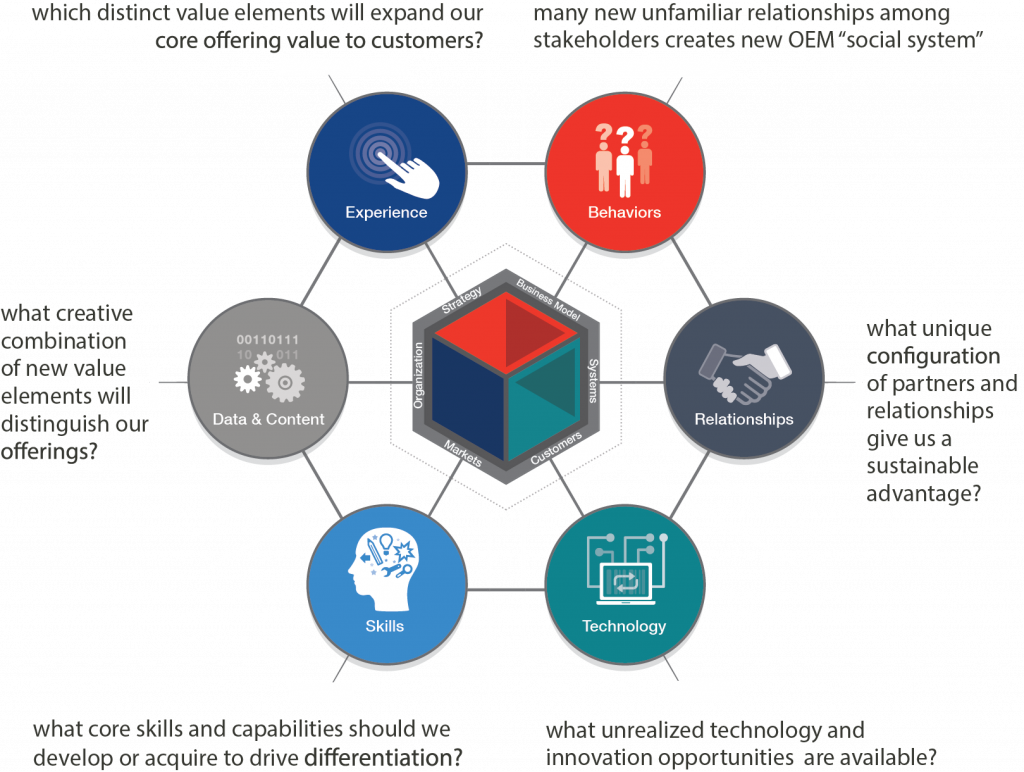Re-Thinking Growth
Strategy and Innovation
We are still living in a world where most organizations view new technologies as “bolt-ons”—something closer to a supplement, a vitamin they can take. The simple fact is that Smart Systems and their underlying combinations of technologies are far more disruptive than previous generations of innovation. Smart Systems will drive a much closer coupling of technology architecture and business architecture.
Introduction
As we end the second decade of the 21st century, many of our biggest challenges and issues in business still originate directly from our inability to creatively imagine radically different futures. We continue to live in profit-and-loss silos and old risk-management scenarios despite new digital technologies that offer more opportunities to create new business concepts than we’ve ever seen before.
Many large corporations have tried to embrace many new technologies, of course, but with marginal success. Most of their efforts have really just focused on achieving new operating efficiencies. Business leaders have spent the last 30 years optimizing functions and sucking the fat out of the enterprise, making their businesses as lean and profitable as possible. The problem is, they’ve also siphoned off most of the growth opportunities.
In short, established product manufacturers and services providers are operating with outdated strategies and innovation models that were conceived in the post-WWII era, and cannot serve the needs of a truly connected world. Corporate executives are falling far short of the creativity required to take advantage of this new era.
Strategists Need New Methods, Processes and Frameworks

Creative Combinations of Technologies Will Change Everything
Multiple parallel technology developments are now increasingly reinforcing and accelerating one another. Cloud infrastructure resources are providing unprecedented computing scale. Higher performance wireless networks and mobile computing devices are extending the reach of computing. Machine learning and AI are bringing intelligence to diverse edge-of-the-network things. And embedded systems and IoT technology are connecting and integrating a broad array of physical and digital applications.
Harbor Research uses the term “Smart Systems” to describe this phenomenon—a new generation of computing and information architecture that looks very different from classical information, computing, and telecom systems.
New embedded intelligence, networking, and software innovations are all in some way trying to break from today’s computing and telecom paradigms to enable real-time, state-based, context-sensitive capabilities. Smart Systems enable intelligent real-world physical systems to be integrated with virtual digital systems, allowing the data from sensors, machines, video streams, maps, people, news feeds and much more to become an integral part of all information systems.
Smart Systems will enable previously unimagined capabilities for both the B2B and B2C worlds. After years of frustrating fits and starts, creative combinations of new technology will integrate people, processes, and data in ways that enable collective awareness and better decision making. The question is whether business leadership is ready to make the leap and grasp its potential.
Crisis of Perception
In times of radical change, crises of perception are often the cause of significant failures, particularly in large companies. Such failures result from the inability to see emergent discontinuities. We believe this to be the case with most large established manufacturers and services providers whose assumptions about future competitive strategy and value creation are being shaped by the past. Too often, executives merely extrapolate the past into the future in a linear fashion.
But before we delve any further into this thinking, let’s talk about why it’s necessary at all.
Don’t most large manufacturers and services companies continue to grow and create shareholder value? Haven’t many of these players embraced “digital” already? Don’t we already have vast connectedness between and among institutions and enterprises via the Internet? Didn’t the Web completely revolutionize human communications?
Almost everyone will answer with a resounding “Yes!” But consider this analogy from Buckminster Fuller: Suppose you are traveling on an ocean liner that suddenly begins to sink. If you rip the lid off the grand piano in the ballroom, throw it overboard, and jump on it, the floating piano lid may well save your life. But if, under normal circumstances, you set about to design the best possible life preserver, are you going to come up with the lid of a grand piano?
Current corporate development protocols and strategies for growth and value creation are like that piano lid. In a period of great change and tumult, they might work—in the sense that they could keep us afloat. But that does not make them the best possible design, or qualify them to be something that we can build on and use forever.
Global expansion. Re-engineering. Lean practices. Mergers and acquisitions. For most companies, these strategies for growth and value creation are finally reaching the point of diminishing returns. Such approaches leave little room for dynamic management or creation of change, or the early identification of emerging opportunities and disruptions, or the increased presence of unfamiliar competitors. Traditional strategy development and planning processes, with their linear view and built-in bias toward the established and predictable, fail to prepare a company for change.
The Tyranny of Replication
The modern business enterprise has been deconstructing for decades. Companies used to develop the logistics, tools, processes, and plans they needed right inside their four walls. Today, no one thinks of a company as bound by the four walls of a building. Companies are ecosystems now, value-delivery networks consisting of a disassembled set of business functions and entities—some owned directly, many sub-contracted, but all requiring orchestration, and all requiring new modes of strategic development.
Most large organizations appear to be trapped by a tyranny of replication. Established businesses will need to be better at spotting emergent trends and being able to quickly respond to new market entrants leveraging unfamiliar technologies. In this fast-changing environment, leadership’s ability to identify emergent trends and potential discontinuities will become a minimum requirement.
We are still living in a world where most organizations view new technologies as “bolt-ons”—something closer to a supplement, a vitamin they can take. The simple fact is that Smart Systems and their underlying combinations of technologies are far more disruptive than previous generations of innovation. Smart Systems will drive a much closer coupling of technology architecture and business architecture.
We believe that for the first time in the evolution of networked businesses, these two “architectures” must be viewed in close proximity. The two thrusts—business and technology—need to be mutually supportive, without one inhibiting the other. However, trying to coordinate and leverage the respective roles of technology architecture and business architecture often creates contention.
Many of the participants we speak with in this emerging arena are coming to see the continuously evolving relationship between these two dimensions as fertile ground for innovation. The two architectures need to be interwoven and mutually supportive. In fact, from our own direct consulting experiences, we believe success in either arena goes to the company that effectively utilizes the combined potential of both.
In our years of experience, we have all too often seen the unfortunate scenarios that managers create when uncertainty and complexity force them to rely on selective attention. Selective attention naturally gravitates toward what’s readily available: past experience and uncertain assumptions. Many of today’s players are relying on those very things. By ignoring important trends simply because it’s difficult to perceive an alternative future, these managers are leaving the door open for competition that will lead to their eventual demise. Needless to say, this makes for a very interesting world to live in.
This blog post is a summary of our Smart Systems Insight “Catalytic Growth Models and Strategies for OEMs.”
Fill out the form below to download the Insight for free.


